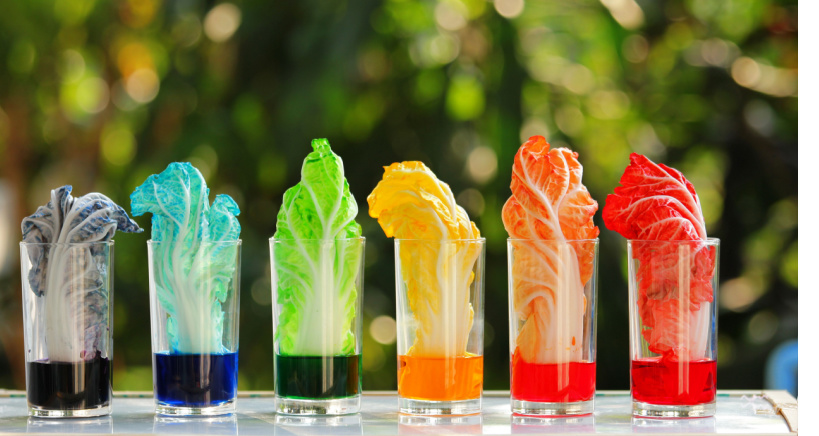 So many of the foods that we eat are associated with their colors: “Taste the Rainbow.” “Golden Delicious Apple.” “Blueberries.” “White Chocolate.” Red Velvet Cake.” Sometimes these colors are a natural outcome of how the food grows or is produced. But, more often than not, in today’s culture of processed foods, our edibles are given artificial colors to make them more appealing and marketable. This includes everything from the use of Red 40 to bequeath Kool Aid with its fluorescent colors to the subtle use of Annatto extract to make Pop Secret’s buttery popcorn look more buttery than it is.
So many of the foods that we eat are associated with their colors: “Taste the Rainbow.” “Golden Delicious Apple.” “Blueberries.” “White Chocolate.” Red Velvet Cake.” Sometimes these colors are a natural outcome of how the food grows or is produced. But, more often than not, in today’s culture of processed foods, our edibles are given artificial colors to make them more appealing and marketable. This includes everything from the use of Red 40 to bequeath Kool Aid with its fluorescent colors to the subtle use of Annatto extract to make Pop Secret’s buttery popcorn look more buttery than it is.
There are a number of reasons and methods to dye foods. And, while food dye colors can be controversial at times, let’s explore how food coloring can help at-home and professional chefs. We’ll look at which dyes to avoid, how to use natural dyes, and what the future of food coloring holds.
In Pursuit of Color
An article in the Journal of Food Engineering surmises that the preference for vibrant food colors may be related to the fact that foods tend to become duller as they decompose, and therefore even our earliest evolutionary ancestors chose the most vivid foods because they were the freshest looking.
In any case, whatever the reason, ancient texts have referenced the colors of foods for millennia, from the Bible’s famous “red lentil soup” that Jacob fed his brother Esau, to the 1st century Roman chef Apicius who coined the phrase, “We eat first with our eyes.” Studies from ancient Egypt suggest that their bread and beer may have been dyed red. Ingredients like saffron, which imparted food with a strong yellow color, and also a strong flavor (and in some cultures were considered aphrodisiacs), were popular throughout history.
In the modern era, fruit producers will often spray oranges with food coloring to make them more orange and dye maraschino cherries so they look more like cherries. And, in medieval times, shady retailers used similar (but more unhealthy) marketing ploys, selling flour mixed with chalk or even ground-up bones to make it appear whiter and richer.
Synthetic Food Colorings and Regulations
By the mid-1800s synthetic food dye colors were ubiquitously used in food products both to pass off fraudulent foods as real and to make products more appealing or beautiful. Originally retailers used naturally-occurring ingredients, but in 1856, inventor William Henry Perkins accidentally stumbled upon the first ever synthetic dye, mauveine, while attempting to create a cure for malaria.
Perkin’s discovery, along with growing industrialization and globalism, ushered in a new era where selling dyed food was the norm. Back then, it was a free for all with all sorts of dangerous and inedible substances being added to foods to change their appearance, including coal, arsenic, and lead. These unscrupulous uses of coloring agents led to a number of deaths, and spurred legislation that regulated the use of food coloring agents and other ingredients. Which is interesting, because the debate about dangerous food dye colors continues even today, in the post-FDA era.
The Butter Wars
There are some interesting anecdotes from the early attempts at regulation. For example, after margarine was invented in the late 19th century, there was a law requiring it to be colored pink, so unscrupulous retailers couldn’t pass it off as butter. Even after this law was repealed, another law banned it from being yellow-colored. Margarine retailers used to sell it alongside a packet of yellow dye for consumers to make their own DIY butter-look-alikes at home.
The Food and Drug Act was passed in 1906 and in 1938 the government followed up with the Federal Food, Drug, and Cosmetic Act which specifically referenced food colorings, making it illegal for food producers to use any synthetic coloring agents that weren’t certified by the FDA. It’s thanks to this act, and the subsequent certification process, that modern coloring additives have names, given to them by the FDA, like Blue No. 1 or Red No. 40. Nowadays there are ten synthetic food coloring additives on the FDA’s list of certified food additives, along with a large number of natural food dye color options that don’t require batch certification.
The Why Behind the Dye
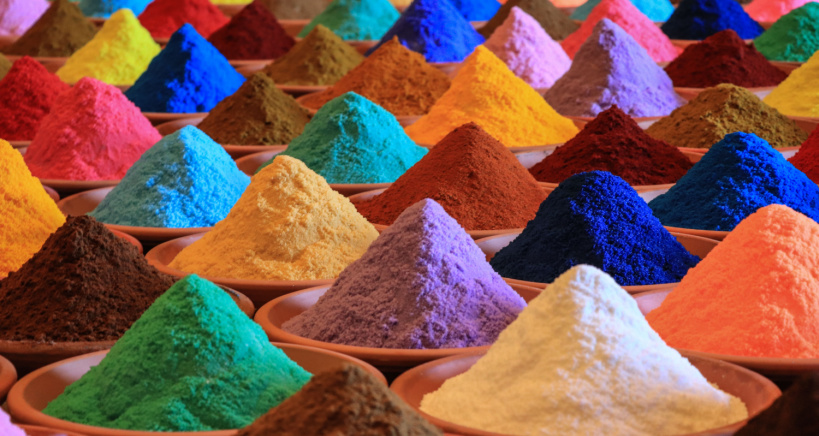 Nowadays much of the processed, and even unprocessed foods (like freshly dyed oranges) that Americans consume have some form of added coloring. It’s almost an expectation at this point. And, there are a number of reasons behind the proliferation of food dye colors.
Nowadays much of the processed, and even unprocessed foods (like freshly dyed oranges) that Americans consume have some form of added coloring. It’s almost an expectation at this point. And, there are a number of reasons behind the proliferation of food dye colors.
Do We Really Eat With Our Eyes?
Firstly, Apicuis was right. We do “eat with our eyes.” In the competitive food industry retailers use all sorts of tactics to make their foodstuff more appealing to consumers, including adding sugar and salt, and making their foods bright, colorful, and tasty looking.
Additionally, most of the mass-marketed products are processed and this can often cause the naturally vibrant colors of foods in nature to diminish. To compensate for this, companies add back these vibrant hues with food coloring.
Another piece of the puzzle is the cultural role that food plays in the modern world. Top restaurants and caterers will spend minutes plating their dishes to make sure that foods are arranged appealingly, and part of that appeal includes the color contrasts. A birthday cake or a wedding cake wouldn’t be the same without the colorful frosting and icing. Sprinkles are an essential part of an ice cream sundae.
But, that drive for visual appeal has to be balanced by the latest consumer trend towards healthier, more wholesome, and “natural” foods, which may reject the use of Blue 2 and Yellow 5. In general, food dyes fit in one of two categories: artificial, “chemical” dyes (like Red 40 and Blue 2) and natural foods dyes – colorings made from ingredients that appear in nature.
Artificial Food Dyes
If artificial food dyes aren’t found naturally, what are they composed of? Surprisingly most are made from petroleum! But don’t let that scare you off. It’s not like the FDA is letting food manufacturers slap a label on colorful crude oil. Instead, food scientists alter the molecular structure of specific components found in petroleum until they no longer resemble or have similar properties to their original ingredient. Food dyes are as different from petroleum as swimming pool chlorine is from sodium chloride, or common table salt.
Why Still Controversial?
Still food dyes are associated with their fair share of controversy. Artificial dyes are accused of causing allergic reactions, hyperactivity in children, and serious health issues, with Red 3 probably being the most infamous owing to the FDA’s discovery that it can cause cancer in laboratory animals. However, Red 3 is still on the FDA’s approved list, and is in nearly 3,000 grocery store products including Nerds, Skittles, and Doritos.
Even though food dyes get a bad rap, they are an inexpensive way to add a pop of fresh color to dishes without impacting their taste or texture or adding any calories. And they are accessible to the average home or restaurant chef in the form of grocery-store food colorings. Most of these food colorings are composed nearly entirely of synthetic food dye.
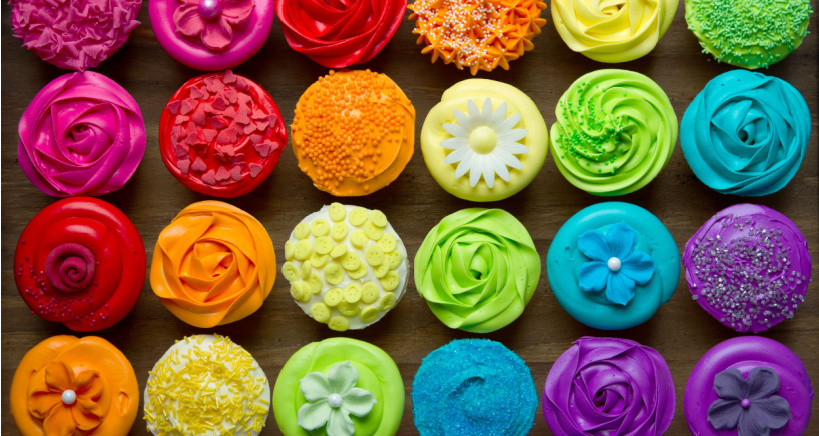 Food colorings have a number of uses in the restaurant kitchen and at home. For example if you are a baker, you can use food coloring to color frosting or icing along the full rainbow spectrum to make beautiful, artistically designed cakes, cookies, cupcakes and meringues. Food dyes can also improve the aesthetic and presentation of a sauce or dressing. Food coloring isn’t just for food, it can be used for beverages as well.
Food colorings have a number of uses in the restaurant kitchen and at home. For example if you are a baker, you can use food coloring to color frosting or icing along the full rainbow spectrum to make beautiful, artistically designed cakes, cookies, cupcakes and meringues. Food dyes can also improve the aesthetic and presentation of a sauce or dressing. Food coloring isn’t just for food, it can be used for beverages as well.
Signature cocktails, and the ingredients in them, can be enhanced with a dash of color. Plus, if your establishment likes to get playful with their food, you can make multi-colored pasta, rainbow sushi, or standout burger buns simply by using a few drops of food coloring. And, while this may sound odd, consider that the rainbow bagel exceeded all expectations in terms of its popularity. Food coloring empowers chefs to add the whim and vibrancy necessary to make ordinary dishes into trending stars.
Natural Food Dyes
On the other hand, the era of processed food and synthetic ingredients is nearing its end and many customers are seeking out healthier, more natural options.
If you want to hop on board this trend, there’s no reason to give up on making unique colorful food. There are a number of options for natural food dyes. Just be aware that if you are marketing a product as “all-natural” you make sure that none of the ingredients in it have artificial dyes (these appear in a surprising number of food products). Also, many of the natural ingredients that add visual appeal also add flavor, so be sure to pick a natural dye that matches both your visual profile and your flavor profile. For example, when it comes to dying buttercream frosting red, strawberries may be a better option than beets or red cabbage.
Make Your Own Food Dye
When it comes to making most food dye colors from scratch, the trick is to start with a powder, because it can dissolve easily into liquid. Ingredients like cocoa (brown), matcha (green), and saffron (yellow) are already optimized for flavorful natural dyes. Vibrantly-hued fruits and vegetables are another good option. Red strawberries and orange carrots are just a few examples of foods that can become natural dyes. If you can’t find powdered versions of these ingredients, you can buy them freeze-dried, and then pound them into a powder in a spice grinder or food processor, or even use a mortar and pestle. Powdered dyes are useful for coloring dry and semi-dry ingredients, like frosting and they can also be mixed into liquids.
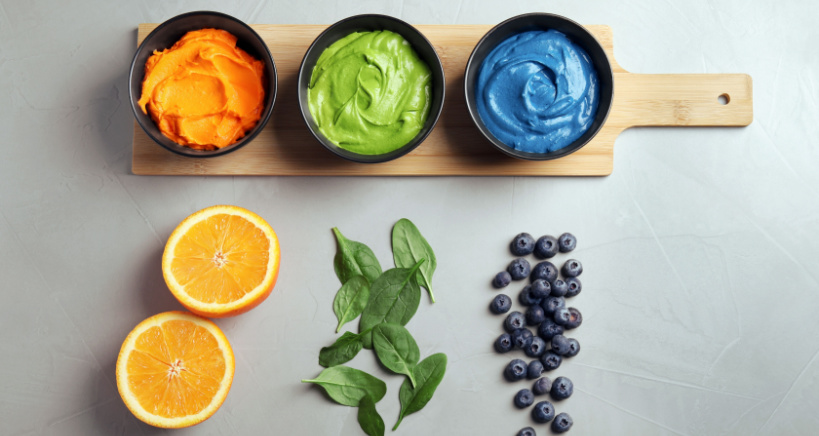 An alternative to the powder route is to juice ingredients in a juicer or puree them with a blender (don’t forget to strain out any solid pieces). The trick to making your natural liquid dyes bright and colorful is by reducing them. First blend or juice to make the liquid, and then heat it or let it evaporate on its own, until the color becomes much more concentrated. Always allow the dye to cool fully before using it in a recipe. Note that colorings can change or dull with heat, so if you are cooking it, you may want to add the coloring afterwards (if possible) or do some experimentation to make sure you get the perfect final color.
An alternative to the powder route is to juice ingredients in a juicer or puree them with a blender (don’t forget to strain out any solid pieces). The trick to making your natural liquid dyes bright and colorful is by reducing them. First blend or juice to make the liquid, and then heat it or let it evaporate on its own, until the color becomes much more concentrated. Always allow the dye to cool fully before using it in a recipe. Note that colorings can change or dull with heat, so if you are cooking it, you may want to add the coloring afterwards (if possible) or do some experimentation to make sure you get the perfect final color.
Other Natural Dye Sources
Some commercially-available natural dyes are made from ingredients that aren’t normally found in foods. For example:
- Carmine is a very popular red dye used in a number of products including Ocean Spray juice and some Yoplait yogurts. It is derived from the dried shells of cochineal beetles. Carmine is an ancient dye used by the Aztecs and other South American tribes for hundreds of years. Carmine is also used in a number of non-food products like ink and cosmetics.
- Annatto, made from the seeds of the achiote tree, imparts an orangish yellowish color and is popular among food manufacturers who want to market their product as all-natural. In some cuisines annatto is used as a spice and it has a nutmeg-like taste. Cheese manufacturers have been using annatto to dye their cheese for around 300 years.
- Turmeric, paprika, and saffron are other spices with a long history doubling as food and clothing dyes. Saffron was one of the most popular spices to travel along the ancient silk road and other trade routes.
- Phycocyanin is a naturally-occuring compound with a deep blue hue. It’s what gives the superfood spirulina (the star of the popular “blue smoothies”) its bright blue color.
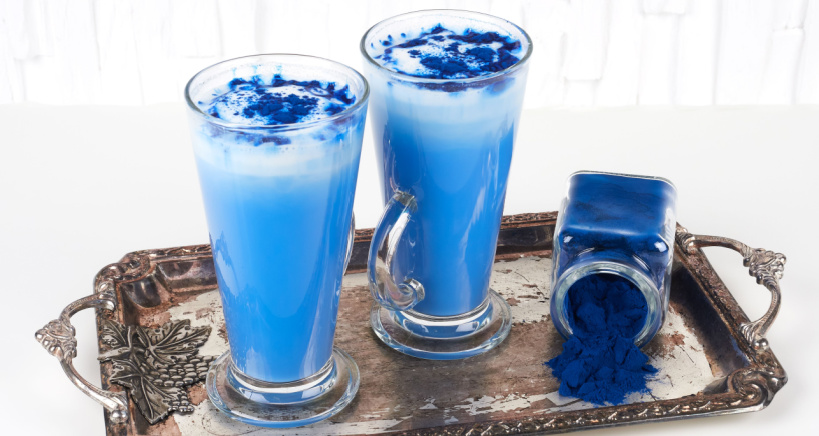
- Chlorophyll is the pigment that makes green vegetables, grass, and leaves green. It can be extracted from plants using a chemical solvent and repackaged as a natural green dye. Commercially-available chlorophyll is often extracted from alfalfa, nettles, or grass and sometimes mixed with copper ions to increase the durability of the color.
- Hibiscus is a flower that can be used to make a vibrant purple-red dye which is most commonly found in wines and beverages.
- Squid ink gets its dark color from the compound melanin and is becoming increasingly popular as a black and dark blue food dye. Not only is it a durable non-heat sensitive dye, it also confers health benefits like antioxidants and amino acids on the recipes it is used in.
Many of these ingredients are used by commercial food manufacturers, but Whole Foods and other similar retailers also sell natural food colorings that contain these ingredients and others, if you don’t want to DIY.
The Future is Bright – Literally
The food industry is always improving and looking for new products to tempt consumers and manufacturers. With consumers spurning artificial dyes, much research has been going into finding cheap, shelf-stable, and durable natural dyes, along with less controversial synthetic options.
One possibility that is getting a lot of airtime is algae. Algae grows in salty and nutritionally poor soils and can be produced cheaply and with relatively little environmental impact. Ordinary algae contains chlorophyll which can be extracted and used as a cheap, natural green dye, while other algaes like spirulina may hold the secret to blue dyes. Scientists are also looking for ways to introduce genes that will cause algae to produce beta-carotene, a vibrant orange pigment.
Another option for sustainable, inexpensive food dyes in the future may come from fungus. General Mills and other major food brands have invested in companies experimenting with the pigment possibilities of mushrooms, mildews, and molds. These companies aim to marry the power of fermentation with the power of genetic modification to produce long-lasting, cheap, natural dyes.
From its earliest roots, where colorful foods may have helped our prehistoric ancestors differentiate between moldy and fresh foods, to the future possibilities where the dye itself is produced from mold, color has played a pivotal role in our dining experiences. Those in the food industry may choose to use synthetic, cheaply available food colorings to create more aesthetically-pleasing dishes, or hop on the all-natural trend with DIY and commercially-available dyes. When it comes to food and colors, the possibilities are endless.